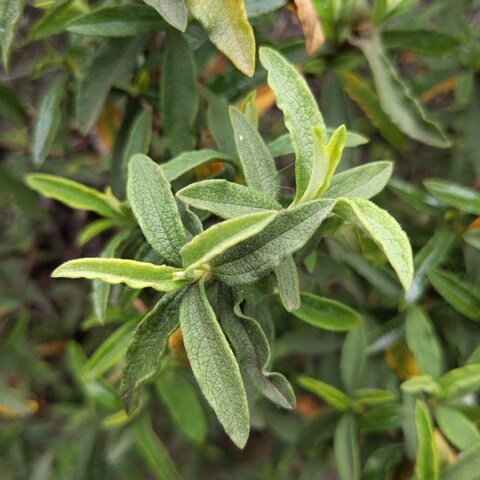I grew up going to church, and periodically we would have "special services" where incense was burned. I don't know what type of resin was used, but I remember the smell very distinctly. I don't know how to describe it, though. Very warm, dark, woody and slightly aromatic (a bit like sage)? No words can really capture the complexity and beauty of this smell. I have smelled it in perfumery twice so far: it's the primary scent in  Vétiver oriental, and I've also accidentally recreated it by combining mimosa, tiare flower, patchouli and agarwood in one of my own perfume creations.
Vétiver oriental, and I've also accidentally recreated it by combining mimosa, tiare flower, patchouli and agarwood in one of my own perfume creations.
Today while running some errands, I passed a stretch of pavement where I smelled this exact scent. I thought nothing of it the first time I passed, but the second time, I was looking around and notice a hedge made of plants that looked familiar. I got out my plant identification app and just as I suspected, they were Cistus species. They were not flowering, I was only smelling the leaves.
I'm aware that labdanum comes from the Cistus plant, but I've smelled labdanum absolute and it's very different to this mystery resin I'm trying to identify: much sweeter, smoother and less complex. Labdanum is a smell I associated with the "amber" accord whereas my mystery resin is not.
I'm wondering if anyone knows the smell I'm talking about and can identify what resin might have been burned as incense at my church. I know it's not frankincense because I have  L'orpheline and it doesn't smell like that and I've also had various cone incenses that use frankincense and it doesn't smell like that either. Nor does it smells like dragon's blood incense.
L'orpheline and it doesn't smell like that and I've also had various cone incenses that use frankincense and it doesn't smell like that either. Nor does it smells like dragon's blood incense.
Also, I've always wondered why some perfumes say they contain "labdanum" and some say they contain "cistus". What is the difference? Are these using different parts of the plant that smell different?
P.S. see attached photo of lovely smelling plant



 Ambre sultan
Ambre sultan 

 La Liturgie des Heures
La Liturgie des Heures
 Cardinal
Cardinal Armani Privé - Bois d'Encens
Armani Privé - Bois d'Encens Olibanum
Olibanum Attaquer Le Soleil - Marquis de Sade
Attaquer Le Soleil - Marquis de Sade